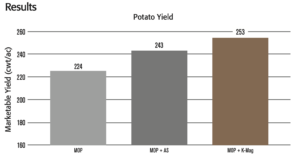Overview
- Along with Phosphorus (P), Potassium (K), Magnesium (Mg), and Sulfur (S) are macronutrients needed for a balanced crop nutrition program in potatoes.
- Magnesium is critical for disease resistance, skin quality, increased dry matter and starch levels.
- Ensuring K, Mg, and S availability through bulking can be difficult on coarse, well-drained sandy soils.
- K-Mag is a unique 3-in-1 nutrient source that features low chloride, water soluble nutrient, and does not affect soil pH; regardless of application rate.
Trial Details
Locations and Crop Management:
CROP: Potato (Solanum tuberosum)
YEARS: 2018-2019
LOCATIONS: 2 trials on Prince Edward Island
DATA SOURCE: Field studies conducted by independent third-party researchers.
EXPERIMENTAL DESIGN: Small-plot RCBD with 4 replications.
Cultivar: Russet Burbank
CROPPING CONDITIONS:
N Rate: Followed local practice with 50% at preplant and the rest applied in-season.
P Rate: 160-200 lbs P₂O₅ /ac applied as DAP
K Rate: 240 lbs K₂O/ac as MOP | 210 lbs K₂O/ac as MOP + 30 lbs K₂O/ac as K-Mag
S Rate: 30 lbs S/ac as AS or K-Mag
Application Timing and Method: Preplant broadcast and incorporated

Summary
- The addition of S as AS increased yield by 19 cwt/ac over MOP.
- Compared to a treatment with only K (MOP) and S (AS), the addition of Mg from K-Mag increased yield 10 cwt/ac.
- Replacing a small amount of MOP with K-Mag increased yield by 29 cwt/ac over MOP alone.
- The K, Mg, and S found in K-Mag provide a great source of necessary macronutrients (primary and secondary) to provide a balanced crop nutrition program in potatoes.